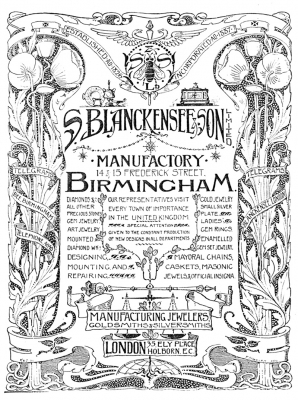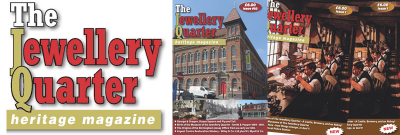 In Bristol in the year 1826, Solomon Blanckensee, a dealer in jewellery, began trading in his own name.
In Bristol in the year 1826, Solomon Blanckensee, a dealer in jewellery, began trading in his own name.
The event proved to be one of some importance, for the firm he then founded grew rapidly and in the course of years absorbed a number of other prominent concerns, until 1936, in point of size and the variety and excellence of its products, it had few rivals in the jewellery industry.
Solomon Blanckensee stayed in Bristol for only a few years, and then moved to Birmingham.
He occupied a small 19th century house in Great Charles Street with his wife and family, conducting his business from the same premises, and built up a most successful concern. He died in 1863 and was succeeded by his two sons, Abraham and Aaron. The former died ten years later, when the surviving partner took his younger brother, Julius, into partnership.
In 1885 they acquired the old-established factoring business of Emanuel & Davis, moving at the same time from Great Charles Street into premises at 14/15, Frederick Street.
Two years later another old-established firm of factors, Simeon Greenberg, was absorbed.
Aaron Blanckensee’s son, Sidney, entered the business in 1885. At that time, S Blanckensee & Son had become one of the foremost firms of jewellers’ factors in the country. Sydney Blanckensee realized that the firm could never progress as his ambitions demanded until they manufactured the goods they distributed, and he persuaded his father and his uncle to start mounting a few rings, brooches and pieces of fancy jewellery.
From this period the firm started the rapid development which resulted in 1936 in S. B. & S., Ltd. actually manufacturing practically every article sold by the modern jeweller and silversmith, with the exception of clocks, watches and cutlery.
Aaron died in 1902, and shortly after the progressive concern of Isaac Silverston was bought.
Julius died in 1912, and Sidney took control. He was not content that the firm should manufacture only jewellery, and decided there was a great future for the manufacturing silversmith.
He acquired the well-known silversmiths’ business of Nathan & Hayes, and moved it to Great Hampton Street, where a successful manufacturing silver section was established.
In 1916 the Albion Chain Co. was purchased, a further development on the manufacturing side. The wedding ring department of this business, already a feature, was developed and soon grew to such an extent that more than 100.000 rings left the factory every year.
In this programme of development, the Managing Director was assisted by his brother, Harry, who supervised the London side of the business, and by Walter Davis, who attended to the financial side. When in 1923 his son Arnold and nephew Leslie, and in 1928 his second son Denis joined the firm, they found a manufacturing business employing about 600 people, perfect in many branches of a complete industry.
Then further progress was made. The silver factory absorbed the old manufacturing business of Stokes & Ireland, and in 1929 the business of A & J Zimmerman, and the whole of the silver organization was transferred to their up-to-date factory in Regent Place.
After the Second World War, sporting events in both Great Britain and the Colonies became more numerous, and the trade was required to supply an ever-increasing number of prizes and trophies. There was room for further development at Regent Place, so during the current year the old-established firm of J W Tiptaft Ltd., was also absorbed. Not only were Tiptaft’s one of the finest sporting trophy manufacturers in England, but also specialists in the fancy enamel industry – another very welcomed addition to the many productions of the firm of Blanckensee.
Source: British Jeweller May 1936
Printed in: The Hockley Flyer Issue 351 October 2014
Printed in: The Jewellery Quarter Heritage magazine Issue 1















